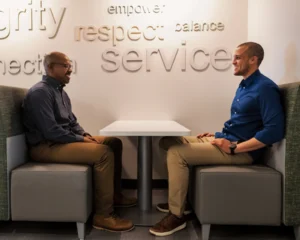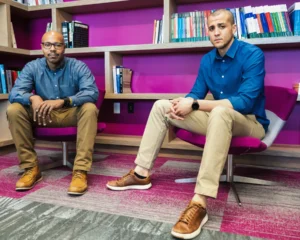Creating diversity in the architecture and engineering industry has historically been challenging. While progress has been made, the industry lacks people of color overall. According to the Directory of African American Architects, less than 2.5% (2,492) of licensed architects in the United States are Black.
The Galloway People of Color (GPOC) initiative explicitly acknowledges the inherent value of persons of color and fosters an environment for ideas and experiences to be shared, contributing to personal, company, and community growth. Black History Month is an opportunity for Galloway to continue communicating with, learning from, and listening to our diverse individuals.
 Blake Olson, an architectural project manager and senior associate, and Ray Stubblefield, a regional architectural project manager, share their experiences as Black architects in the industry.
Blake Olson, an architectural project manager and senior associate, and Ray Stubblefield, a regional architectural project manager, share their experiences as Black architects in the industry.
Blake: I did not grow up playing Legos or have anyone I looked up to in architecture. My family members were in nursing and business. Still, I was good at math and science, so my parents pushed me to pursue architecture and engineering even though they did not know what an architect or engineer was. I took some CADD classes in high school and participated in the ACE Mentorship program, where I discovered I enjoyed creating spaces and feeling like I would be part of people’s lives whether they knew it or not.
Ray: Like Blake, I did not necessarily have anyone I looked up to, but I always liked building things with my hands. I remember being four years old and making my basketball hoop. Later in my childhood, I lived with my older cousin, who exposed me to drawing, sketching, and being creative. Then it all culminated when my mama took me to the St. Louis Art Museum when I was 10. Sitting on the wall, I saw the exit plan for egressing out of the building in an emergency. I remember seeing that plan and thinking, ‘I want to do that,’ I already knew I wanted to go to Kansas State. When I went to Kansas State, I realized this was my dream, and I will do it no matter what.
Blake: There were still very few people of color in school. It was me and maybe one or two other Black architects. Post-graduation, I still do not meet too many Black architects unless it is at corporate events. You realize that as cool as it is to keep trailblazing, it is exhausting.
When I meet other architects of color, I feel a weight lifted off my shoulders that I do not have to represent the entire race. It is also nice because I can relate to them in different ways and in the way that most of us did not see anybody who looked like us during our journeys. So, it was great to meet Ray. At Galloway, we are doing as well as we can with diversity in the industry as we grow.
Ray: My experiences are similar to Blake’s. At school, only a handful of professors and students were people of color. I always had to tell myself to be comfortable and that I belonged even though no one looked like me. I did a research project on Paul Revere Williams, who used to make his clients, primarily rich Hollywood stars, feel comfortable by standing on the opposite side of the table and drawing upside down so that he could earn their business. I would think about that because I felt isolated growing up in the Midwest.
My exposure to architects of color and comfort level was not enhanced until I moved to Atlanta. I was blown away by the diversity. Being in Atlanta has refueled me and given me hope for the younger professionals after me. My involvement in NOMA and AIA Atlanta makes me feel like my voice matters, I can have a positive impact, and I belong.
Blake: I was never a good hand drawer, and graduating at the end of the 2008 recession was tough. My real challenge was finding my voice and realizing the hats you wear as an architect of color. It would be nice to be the best architect I can be, but does representation matter if you are not visible? I feel responsible for laying the foundation for the people after me and helping change the community.
I also feel responsible for doing something at a higher level within and outside of my profession. I am wearing the hat of a licensed architect and Sr. Associate at Galloway, but also, due to my skin color, I represent a group of people rarely seen in this industry. Even though it is not right, people view people who look like me based on my interactions.
Ray: There was a time I did not tell people what I did because I did not believe in myself. It was a challenge to find my confidence and identity within the profession. My challenge is overcoming the fact that people of my skin color tend to get fewer opportunities. I don’t want my skin color to be why my chances fail.
Blake: Sometimes, the challenge is almost the reverse. You do not want to be there because you are tokenized. You want to be appreciated for your work and get promoted based on merit, not because your skin color checks a diversity box.
Ray: I agree. Someone must be the trailblazer, and you do not want to pass up opportunities. So there is a balance there you have to manage.
Blake: Do not be afraid of failure. Mistakes are inevitable, and you won’t learn unless you make them. Learn from them quickly and ensure it does not happen again. Second, being a team player is paramount. It is how you will work most of the time and how you will progress in your career. Third, be excellent at your craft, be a constant student of the industry, and work hard. Unfortunately, because of your skin color, you might not get the same opportunities or second chances. Hard work always pays off, even if it is not in the short term.
Ray: Design the life and career you want to have. We all have our idea of success, but what are you doing to reach yours? Continue to strengthen your strengths and work on your weaknesses. Become an expert in something you are passionate about, whether code, Revit, or renderings and animations. Become involved in professional organizations because networking and meeting people will help you with your self-confidence and expose you to potential opportunities.
Get licensed. You owe it to yourself. You do all the schooling and late nights in the studio. You are more valuable to yourself and your company if you are licensed. It will help with being agile and your upward mobility.
Take risks, believe in yourself, and get what you want.
Blake: I think Galloway has been nothing but accepting. The diversity at Galloway continues to develop, and so does the program, whether it is including preferred pronouns, supporting the affinity groups we have, supporting the lunchtime conversations about topics that matter to our employees and the nation, or giving our time to local organizations who support underserved minority communities. It shows the authenticity of who Galloway is. It does not just talk or a quick social post. This matters to us, and we are putting our money behind it. There are always things we can improve on, but I can say that I am proud and thankful for what Galloway has become so far.
As far as my role, I got involved in 2018. Diversity was part of the strategic plan for several years. With the help of other leaders in our diversity initiative, we worked on enhancing our culture and making everyone feel comfortable regardless of their background.
Ray: Having been here only about six months, I can say that Galloway’s diversity initiatives attracted me to the company. It meant a lot that justice, equity, diversity, and inclusion matter in the public view. They are doing something about it with strategies, initiatives, and company engagement internally and externally.
I have participated in the lunchtime conversations, and those are discussions that need to be had. The raw, the real, the truthful. I think it is great we have these because you will not attract or retain any talent without these discussion topics. We can always be better, but we are headed in the right direction and remain at the forefront.
 Blake Olson has over ten years of experience in architectural design and has been with Galloway for seven of those years, where he has elevated himself from an architectural designer to his current position of architectural project manager.
Blake Olson has over ten years of experience in architectural design and has been with Galloway for seven of those years, where he has elevated himself from an architectural designer to his current position of architectural project manager.
He excels in management, leadership, and mentoring capacities and is committed to being an instrument of change at work and within the community. Under his leadership, he has significantly elevated Galloway’s strategic planning efforts around DEI by setting clear objectives, building a team to support these objectives, and shepherding actionable items until they are accomplished.
Outside of Galloway, Blake mentors architecture students, volunteers at “Reading Partners” – a tutoring program to help elementary school students read at grade level, and provides mentorship and support to incarcerated youth.
Olson is also a member of AIA, NCARB, and NOMA. He received his bachelor’s degree in environmental design in 2009 and his Master’s in Architecture in 2011 from the University of Colorado. He is currently 1 of 23 Black licensed architects in Colorado.
Ray Stubblefield
Ray brings 16 years of experience as a regional architectural project manager for Galloway’s Atlanta office. His background includes all phases of architectural design and construction administration in public and private sectors, including government facilities, retail, hospitality, multifamily residential, mixed-use, office, restaurant, and parking structures.
He is highly knowledgeable in applying building codes, life safety requirements, and ADA standards. His insightful approach helps Galloway provide its clients with designs that are safe and accessible while still representing and enhancing the needed function and the aesthetics of the communities we serve.
He is a member of AIA, NCARB, and NOMA. He is also LEED AP BD+C certified and licensed in seven states. He received his Bachelor of Architecture in 2006 and his Master of Science in 2018 from Kansas State University. Stubblefield is currently 1 of 205 Black-licensed architects in Georgia.
We are nationally recognized and locally preferred. We would love to work with you on your next project.
Contact Us